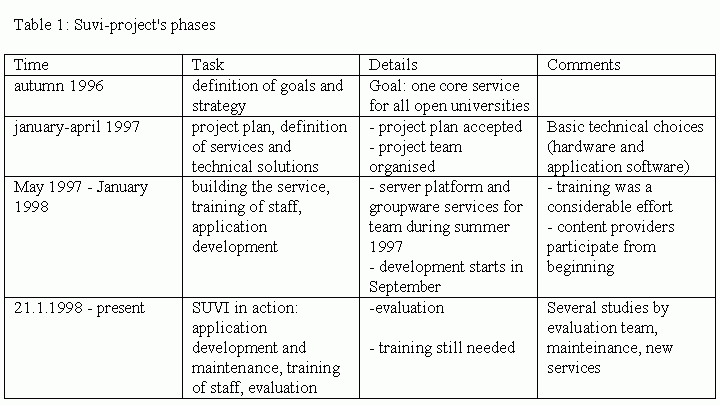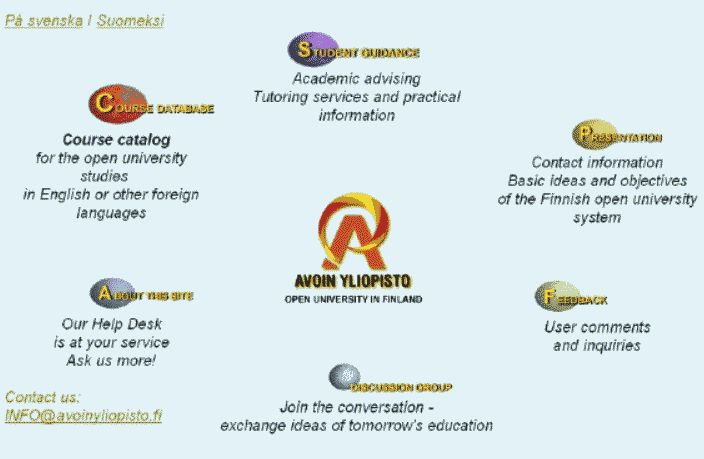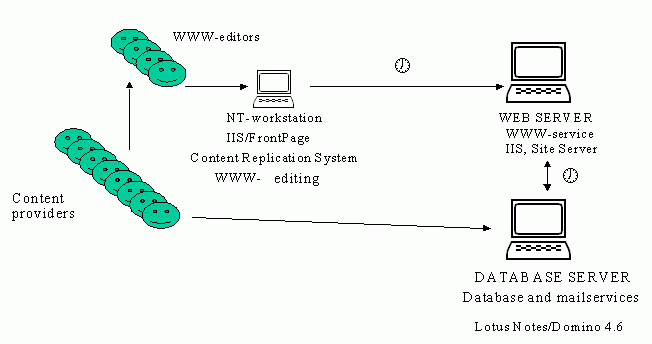The ambitious goal of building a joint information service for all 19 open universities was realised within schedule.The service (http://www.avoinyliopisto.fi) has been functional since January 1998 in Finnish, Swedish, and parts of it also in English. For public, it offers information on Open University education. The main attraction is the course database, which contains up to date information on all Open University education in Finland. It also provides intranet-services for the staff.
Open Universities offer higher education to all, and have always had interest in finding new and efficient ways of informing potential students. Internet seemed to be just the right tool for them. The number of students at Open Universities also grew from 39000 in 1990 to 75000 in 1997, partly because government increased Open University financing as one remedy for record high unemployment. Finnish Ministry of Education was at the same time engaged in networking all educational institutions as a part of a national 'Information Society' program. In 1997, it launched a project to build a joint information service for all the Open Universities, and 21.1.1998 the service was opened.
This paper presents this SUVI project. Finnish Open Universities are briefly described (section 2), as necessary background information for the project's basic ideas, goals and organisation (section 3). The services are briefly described (section 4) and technical solutions are summarised (section 5), with a more detailed discussion on/of the core application.
Open University of Finland is not a separate educational organisation. Nineteen universities have an Open University department as a special unit, and they offer education in the fields of study available within the university in question. Anybody can participate in Open University courses, regardless of age or educational background, and teaching is to be offered at cost prices. The university departments are responsible for the teaching, syllabus and requirements of the courses. Open University organises the courses, selects the students, and awards and records their study credits. It is possible to take basic, intermediate, and even advanced level studies at the open universities, but no degrees are granted. However, the study credits at Open University are transferable, if the student is admitted into a regular university.
The Open Universities were keenly interested in "using the web", and 1996 they had more or less advanced web pages, providing basic "one way" information for students. They were also exploring the possibilities of the web for learning, usually as a supplement to traditional classroom teaching, using tools like newsgroups, discussion groups and email to add some interaction. In some of them, the possibilities of fully or partially net-based learning were explored, and for a good reason. Time (mostly night classes) and distance (courses are usually organise in various locations around university cities) were all too familiar problems for both the staff and the students.
Open universities are however administratively tied to the practices and back office systems of the respective universities. The growing number of students and potential students did not have a single entry point to this spontaneously growing labyrinth of web sites. Representation of the information was diverse, standard user interface or truly interactive guidance services were not available.
The visions of a Virtual Open University, web-based learning, student guidance services and lifelong learning needed a common strategy, and in fall 1996 Ministry of Education commissioned a plan to provide it.
The main task was to provide a strategy for a Virtual Open University in Finland. The essential idea was to promote co-operation and co-ordination as widely as possible, and at the same time build a joint information service for open universities. In defining the design goals and requirements, two ideas were taken as a starting point:
(1) In a relatively short time-span, it is not possible to design a complete integrated information system for Open Universities. Therefore, some basic services should be identified. These services should provide real value to the users, both students and staff of the Open Universities (teachers, www-editors, and administrative staff.
(2) The project should be organised so that several Open Universities can participate in it; the enthusiasm and interest by the content providers was regarded as a valuable resource. Development time should be minimised; the system must however, be scalable and as modular as possible, so that new features can be added without difficulty. Teamware services (e.g. discussion groups, e-mail, collaboration tools) should be made available from the start.
The project was launched in spring 1997, and its overall progress is outlined in Table 1. The project was completed within schedule, and in retrospect two factors made that possible. The task was narrowed down to a realistic but useful joint information service. We also succeeded in organising the project from the start so, that content providers had their say all the way through the application development phase.
The project team worked (and still does) in five different locations in four cities. University of Helsinki is responsible for coordinating the project, the editorial staff of the web pages and for the development and maintenance of the system (IT-department). University of Turku produces materials for Student guidance-section and gives online tutoring. University of Tampere is responsible for stakeholder coordination and University of Oulu has been doing the evaluation of the site. This network-model for the project team was a major challenge, and teamware services were provided just in time in summer 1997. These services made it possible to maintain technical documentation "on-line and in real-time". Although this paper discusses mostly the tasks of the technical team (1997-1998 two persons), it should be emphasised that a major part of the work was done by the content providers. The evaluation and analysis of user feedback of all user categories provided valuable insights in the application development (for a review, see Tuomela (1999)).

SUVI provides services for two categories of users, which are briefly described in this section. The SUVI production environment for content providers is discussed in next section.
The course database is a real-time service on available Open University courses in all open universities. Over 150 staff members around the country continuously update it. It includes extensive information on studies, such as
Users can browse information by branch of study, university, city, studying mode or language of interest, or use the full text search or advanced query form.
The editorial staff has also collected information on education for elderly people, summer universities and Studia Generalia - public lectures.
The student guidance pages have been another popular part of the service (for details, see Suvanto (1998)). These pages contain practical information about the Open University studies and give tips for improving learning skills. The user can browse through web-material, get individual counselling from online tutors or participate in discussion groups.
The user can also require individual counselling via Internet by using email or online chat. Counsellors from University of Turku answer all the questions sent to info-address of the service. One can also contact a specific Open University counsellor. All counsellors of the Finnish Open universities are presented on the web pages. Frequently asked questions are collected into one web page.
News-pages keep users updated with the latest news on the area of Open University education. All public lectures and special events around Finland are presented in one calendar. Up-to date information, such as recent changes on course schedules are also available.
Information pages deal with the basic ideas and objectives of the Finnish Open University system. Institution's producing education, as well as co-operating organisations are presented along with statistics of student enrolment from past to present.
To help students in the search of knowledge, pages are included with guidance in the use of virtual libraries and databases. If university terminology seems problematic, explanations can be found in glossaries. All the Open University publications are presented on their own pages and a second-hand bookstore is open for everyone to trade their old books.
Figure 1 is a screenshot of the SUVI main page, but unfortunately, only parts of our services are available in English.
Figure 1: Suvi services in English, screenshot of the main page

Along the public service, the Suvi-project has produced web-service ("intranet") for employees of the open universities. Access is restricted to staff only, and it is granted by named contact persons in the Open Universities. The service includes a handbook to familiarise employees with the Open University system and tips on updating the material of the public web-service. Announcements and information on matters concerning Open University education are given in discussion groups. Contact information on all employees and their posts can also be easily found on employee's own web pages.
The design goals for the system were set at the outset:
While the other participants of the project were outlining the content of the service (biggest task was defining the course information), the technical team was busily figuring out the platform for the system. In addition to general design goals, a teamware and proto/demo - environment was needed.
The hardware choices were dictated by the design goals: power and scalability. It was difficult to define how much capacity would be needed in peek usage times (normally in the beginning of the terms in August and January, when both the users and content providers are in a rush). Secondly, the same servers would be used as application development platforms, running teamware-services and the core services. It was not feasible to take all these different (resource requirements, optimising of the performance) types of services simultaneously into account. Furthermore, it was reasonable to "ease" the technical constraints, for the timetable was tight. Table 2 summarises the features of the two servers that were purchased in summer 1997.
Table 2: The servers: some technical details

The IT-department provides an appropriate "machine hall" (eg. UPS, air conditioning, security) with regular tape backups and technical "emergency services" when needed.
In the first drafts, the solution was a basic two server model. The idea was naturally to balance the payload between a web-server and a relational database server. This approach was rejected, because it proved to be very difficult to define a relational database for rather diverse course information. The efficiency gain was rather theoretical, and application development resources would have been directed in developing a "from the scratch" -solution.
Instead, we chose to use two application platforms, which provided more resources for rapid application development. These were Lotus Notes (Domino) 4.6 and Microsoft's Internet Information Server (IIS). The former provided the database and teamware services, and the latter web-services. IIS also provided an easy platform for developing more advanced web services, especially with Active Server Pages (ASP).
Notes was chosen (over relational database solutions) primarily for the following reasons:
IIS was chosen as the web server, because it offered (at that time) quite advaced features (spesifically the Active Server Pages). Its tight integration with the chosen operating system (Windows NT 4) was also seen as an advantage for easy application development and minimal maintenance requirements. It is beyond the scope of this paper to evaluate the success in this respect.
The core of the service is the course database, implemented with Lotus Notes. The Notes implementation is a "document database". Designing forms with named text-fields provides the structure. Notes provides full text indexing and search functionality as a built-in feature. A "structural" search capability is provided by hierarchical categories (ie. subject, location, and organising university, time).
Additional features are continuously added to this core application. Open universities can now "dump" selected information from the database to an RTF-file to create printed study guides. We also provided an easy way to create links to specific documents in the course database.
The SUVI production environment includes different tools for database-applications (notes-applications) and web pages. The web pages (both public and intranet) can be edited with any suitable tool, eg. FrontPage. A team of web editors is responsible for the content. One workstation - normally used by one of them - is also used as storage for web pages. Web editors from Turku and Tampere make access to this workstation only: the changes are then automatically or at will, if necessary, replicated to the production web server.
Figure 2: SUVI production environment

Over 150 staff members of all the open universities continuously update it. At present, they use a Notes client, but in the near future, some information will be updated using standard browsers. Members of the team use Notes Client to share information and use the workgroup-tools.
Pitfalls of "hits on this site"-statistics are well known, but they provide some approximation ( a lower bound ?) to the usage of the service. In 1998 the average number of page requests was 80 000 per month (2600 per day), with a peak of 180 000 in August (6000 per day). For a service that does not (yet!) provide exiting surfing experiences the results are reasonably good. Results from user surveys have also been mainly positive.
In this year we have three major development tasks:
Additionally, the intranet for teachers, staff, and developers is reorganised.
Two years is not a long time, some lessons can be listed.
It pays off to define a realisable and concrete service that can be implement quite quickly even if the solution is a bit messy - you can mobilise the existing human capital and build a "networking" team. The communication and co-operation of people is the major challenge. Of course, the service must provide real "value" to both students and the staff.
Documentation is a critical point: the cost of maintenance and development of new services depends directly on the success or the lack of it. With hindsight, this is the major weakness. A necessary condition - although by far not sufficient - is 'real time on-line documentation', for which the tools must be present at the outset. The real test was in January, when a complitely new technical team took over.
Too tight technical constraints - we did not have them - might be dangerous. The developers would have to spend a lot of time optimising a complicated system. There truly is plenty to do, and all this time would have to be taken from other planning tasks, in the worst (but quite probable!) case from the necessary training and support of content providers and staff.
The bottom line is simple: it worked. The system was built in less than a year, and has been fully functional from January 1998.
P.O. Box 26 (Teollisuuskatu 26), FIN-00014 University of Helsinki, IT Department, Finland.
Contact information:
Telephone: +358 9 708 44645
Telefax: +358 9 708 44690
E-mail: Jussi.Hirvonen@Helsinki.fi
Suvanto, Jarno (1998): Finnish Open Universities on the Net, Proceedings of Online Educa Berlin '98, 4th Annual Conference on Technology Supported Learning, pp. 335-338, Berlin, Germany, December 1998.
Tuomela, Sanna (1999): Suomen avointen yliopistojen verkkopalvelun käytettävyyden arviointi. Finnish Information Studies (FIS) 14.
Oulu, 1999 (forthcoming).
Various project plans and drafts of the project 1997 - 1998.